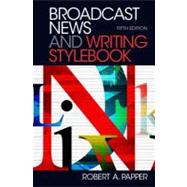
Note: Supplemental materials are not guaranteed with Rental or Used book purchases.
Purchase Benefits
What is included with this book?
Bob Papper is professor and chair of the Department of Journalism, Media Studies, and Public Relations at Hofstra University. A graduate of Columbia College and the Columbia Graduate School of Journalism, he has worked as a producer, writer and manager at television stations in Minneapolis, Washington, DC, San Francisco, and Columbus, Ohio.
1 The Business of News
Ratings
The Scope of Media Use
Media Use Is More Complex Than It Used to Be
It’s Hard to Measure Media Use
What We Think We Know About Media Use
What We Don’t Know About Media Use
So Where Are We Going?
Summary
Key Words & Phrases
Exercises
2 News
What Is News?
Balancing News Values
Types of Stories
Where Story Ideas Come From
The Assignment Desk
The Morning and Afternoon Meetings
Summary
Key Words & Phrases
Exercises
3 Readability
Broadcast News Writing
Writing for the Ear v. Writing for the Eye
Rules of Readability
Summary
Key Words & Phrases
Exercises
4 Words
Keep It Simple
Keep It Conversational
Keep It Clear
Keep It Tight
Make It Powerful
Get It Right
Common Problems
Summary
Key Words & Phrases
Exercises
5 Phrases and Phrasing
How to Say It
What to Say
What You Didn’t Mean to Say
Last Note
Summary
Key Words & Phrases
Exercises
6 Sentences
Keep It Short
Make It Clean, Clear and Concise
Last Note
Summary
Key Words & Phrases
Exercises
7 Leads and Endings
Types of Leads
Figuring out the Lead
Types of Endings
Summary
Key Words & Phrases
Exercises
8 Stories
Plan and Focus
Story Logic
Story Structure
Transitions
Before You’re Done
Summary
Key Words & Phrases
Exercises
9 Working with and Gathering Bites, Actualities and Natural Sound
The Feel of Natural Sound
Collecting Sound
Working with Bites, Actualities and Natural Sound
Packages
Summary
Key Words & Phrases
Exercises
10 Interviewing
Conducting Successful Interviews
Beyond the Interview
Summary
Key Words & Phrases
Exercises
11 Radio/Audio: Story Forms and Working with Sound
Radio Story Forms
Drawing Radio Pictures
Summary
Key Words & Phrases
Exercises
12 TV: Story Forms
Story Forms
Putting Packages Together
Live Reporting
Golden Rules
Summary
Key Words & Phrases
Exercises
13 TV: Working with Pictures
The Power of the Visual Image
The TV Balancing Act
Picture Cautions
Care About the Story
Strong Stories Have Central Characters and a Plot
Prove Your Story
The Element of Surprise
Connecting with Truths
Summary
Key Words & Phrases
Exercises
14 Online News
Some Basic Terms and Concerns
Research and the Web
The Information Web Site
Hyperlocal News
Multimedia
3 Screen Approach to News
Summary
Key Words & Phrases
Exercises
15 Social Media & News
Social Networking
The Bottom Line
Summary
Key Words & Phrases
Exercises
The Radio-Television Digital News Association (RTDNA) Social Media and Blogging Guidelines
16 Convergence, Cooperation & the New TV Newsroom
The New TV Newsroom
Convergence
Cooperation
Mobile
MMJ, Backpack Journalists and One-Man-Bands
Summary
Key Words & Phrases
Exercises
17 Producing News on TV
Overview
Audience
Newscast Structure
Building a Local Newscast
Summary
Key Words & Phrases
Exercises
18 News, Weather & Sports
Why News, Weather & Sports?
Reporting Weather
Defining Terms
Reporting Sports
Sports and Teams
19 Reporting: Seasonal Coverage & the Calendar
Seasonal Reporting
Solar and Lunar and the World’s Major Religions
Calendar Holidays
State Holidays
20 Reporting: Specialized Coverage
The General Assignment Reporter
Business, Economy & Taxes
Crime and Legal
Education
The Environment
Geography
Government
Heath and Medicine
21 Teases and Promos
Promotion
Tease ... Don’t Tell
Make Them Care
Going Too Far
Summary
Key Words & Phrases
22 Ethics and the RTDNA Code of Ethics and Professional Conduct
Ethics
The Radio-Television Digital News Association (RTDNA) Code of Ethics and Professional Conduct
Summary
23 TV Script Form, Supers, and Glossary
Abbreviations
Script Form
Supers
Glossary of Broadcast and Online Terms
Index
The New copy of this book will include any supplemental materials advertised. Please check the title of the book to determine if it should include any access cards, study guides, lab manuals, CDs, etc.
The Used, Rental and eBook copies of this book are not guaranteed to include any supplemental materials. Typically, only the book itself is included. This is true even if the title states it includes any access cards, study guides, lab manuals, CDs, etc.